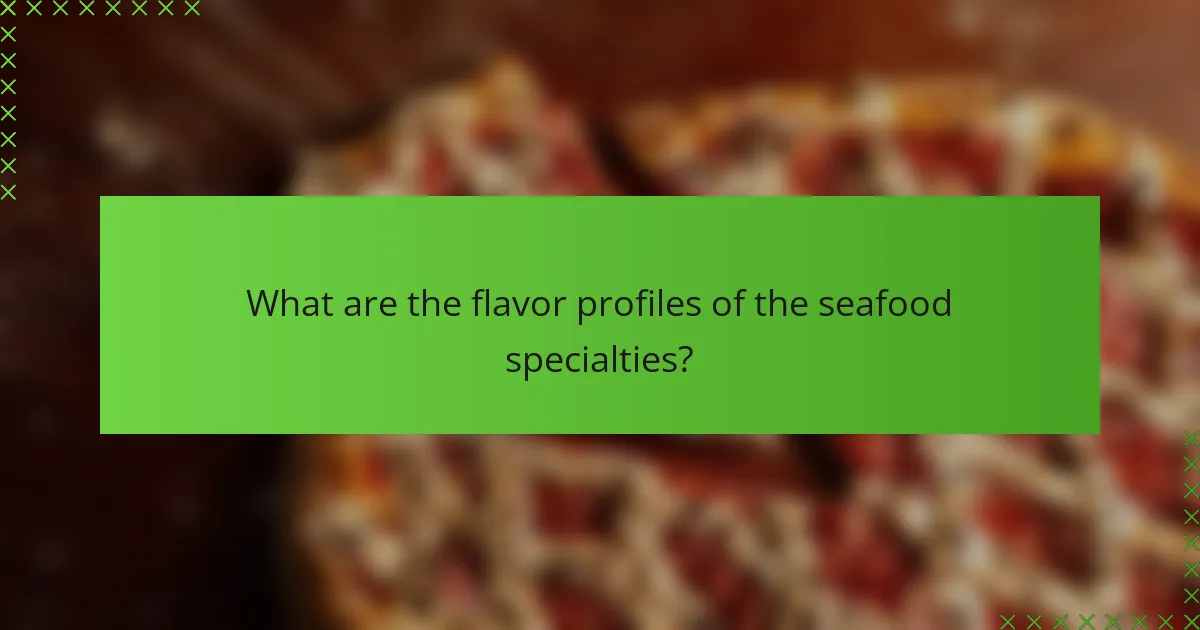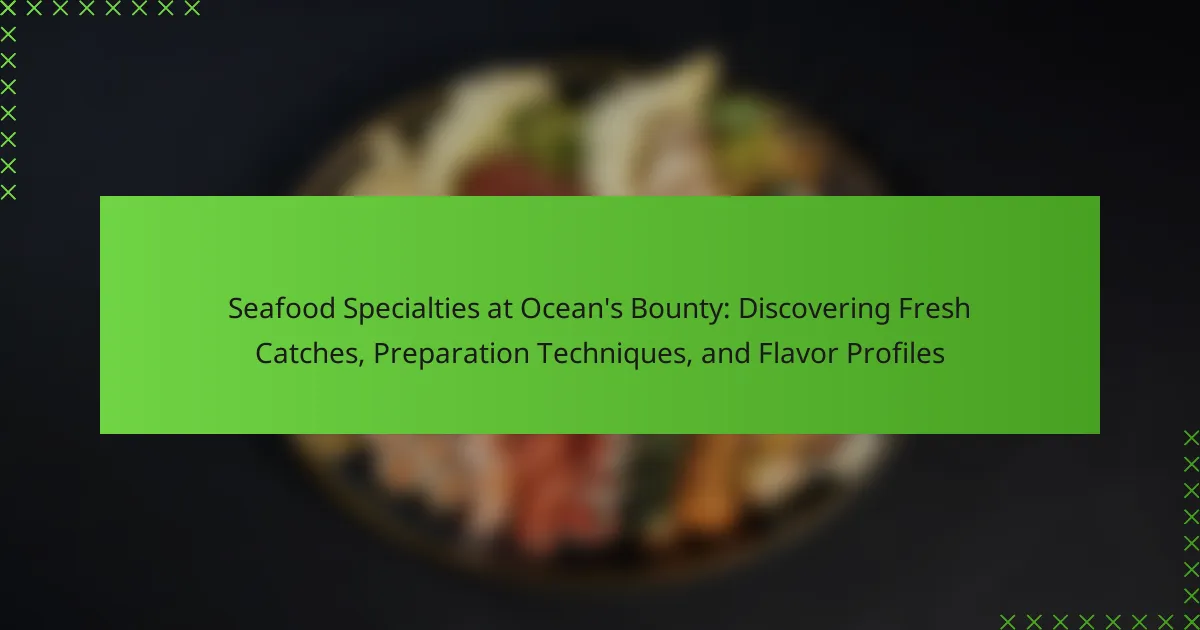
What are the Seafood Specialties at Ocean’s Bounty?
Ocean’s Bounty offers a variety of seafood specialties including grilled salmon, shrimp scampi, and clam chowder. The grilled salmon is known for its rich flavor and flaky texture. Shrimp scampi features succulent shrimp sautéed in garlic and butter. Clam chowder is a creamy soup made with fresh clams and potatoes. Each dish highlights the freshness of the seafood sourced from local waters. The preparation techniques enhance the natural flavors of the ingredients. Ocean’s Bounty prides itself on using sustainable fishing practices. This commitment ensures high-quality seafood for all dishes served.
How does Ocean’s Bounty source its seafood?
Ocean’s Bounty sources its seafood through sustainable fishing practices. They collaborate with local fishermen who adhere to environmental guidelines. This ensures that the seafood is fresh and responsibly harvested. The company prioritizes wild-caught options over farmed seafood. They also participate in traceability programs to monitor the supply chain. These programs verify the origin of the seafood. Ocean’s Bounty emphasizes quality and sustainability in its sourcing methods. This approach helps protect marine ecosystems while providing high-quality seafood to consumers.
What criteria are used to select fresh catches?
Fresh catches are selected based on criteria such as appearance, smell, and texture. The fish should have bright, clear eyes and shiny, moist skin. Fresh seafood emits a clean, ocean-like scent, not a strong or fishy odor. The flesh should be firm and resilient to touch, indicating freshness. Additionally, the gills should be bright red or pink, signaling that the fish is not stale. These criteria ensure the quality and safety of the seafood for consumption.
How does sustainability play a role in sourcing?
Sustainability plays a crucial role in sourcing seafood. It ensures that fish populations are maintained at healthy levels. Sustainable sourcing practices include using fishing methods that minimize environmental impact. These methods help preserve marine ecosystems and biodiversity. Certifications like the Marine Stewardship Council (MSC) indicate sustainably sourced seafood. According to the MSC, certified fisheries follow strict guidelines to prevent overfishing. Sustainable sourcing also supports local economies and communities. This approach fosters responsible consumption and encourages consumer awareness.
What types of seafood are featured at Ocean’s Bounty?
Ocean’s Bounty features a variety of seafood options. The selection includes fresh fish, shrimp, scallops, and crab. Additionally, they offer shellfish like clams and mussels. Seasonal catches may also be available, ensuring freshness. The seafood is sourced from local fisheries. This commitment to quality enhances the dining experience. Each type of seafood is prepared using unique techniques. These methods highlight the natural flavors of the ingredients.
What are the most popular seafood specialties?
The most popular seafood specialties include sushi, lobster, shrimp, and clams. Sushi is a Japanese dish that features vinegared rice and various seafood. Lobster is often boiled or grilled, known for its sweet, tender meat. Shrimp can be prepared in numerous ways, including grilling and frying, making it versatile. Clams are commonly steamed or used in chowders, celebrated for their briny flavor. These specialties are widely enjoyed due to their unique tastes and textures.
How do seasonal variations affect the seafood selection?
Seasonal variations significantly influence seafood selection. Different species are available at various times of the year. For instance, certain fish like salmon are most abundant during specific spawning seasons. In contrast, shellfish such as oysters are often harvested in colder months for optimal taste and quality. Seasonal changes also affect the migration patterns of fish, altering their availability. Additionally, environmental factors like water temperature and salinity impact seafood populations. Consumers often seek seasonal seafood for freshness and flavor. Restaurants and markets adapt their offerings based on these seasonal changes to ensure quality. This practice supports sustainable fishing by aligning with natural breeding cycles.

What preparation techniques are used at Ocean’s Bounty?
Ocean’s Bounty employs several preparation techniques for its seafood specialties. These techniques include grilling, steaming, and poaching. Grilling enhances the natural flavors while adding a smoky char. Steaming preserves moisture and nutrients, resulting in tender seafood. Poaching involves gently cooking in liquid, which maintains texture and flavor. Each technique is selected to complement the freshness of the catch. Ocean’s Bounty prioritizes quality, using sustainable seafood sources. This commitment ensures that the preparation methods yield the best taste and presentation.
How are the seafood dishes prepared?
Seafood dishes are prepared using various techniques that enhance their natural flavors. Common methods include grilling, steaming, frying, and baking. Grilling adds a smoky flavor and is often used for fish fillets and shrimp. Steaming retains moisture and is ideal for delicate seafood like mussels and clams. Frying, either deep or pan-frying, creates a crispy texture, often used for calamari or fish and chips. Baking allows for even cooking and is frequently used for whole fish or casseroles. Each method is tailored to the type of seafood being cooked, ensuring optimal taste and texture.
What cooking methods are commonly employed?
Common cooking methods for seafood include grilling, steaming, baking, frying, and poaching. Grilling enhances flavor through direct heat and adds a smoky taste. Steaming preserves moisture and nutrients while cooking seafood evenly. Baking is a versatile method that allows for various seasonings and toppings. Frying provides a crispy texture and rich flavor, often used for dishes like fish and chips. Poaching gently cooks seafood in liquid, maintaining tenderness and flavor. These methods are widely used in seafood preparation due to their effectiveness in enhancing taste and texture.
How does preparation influence flavor profiles?
Preparation significantly influences flavor profiles by altering the chemical composition and texture of seafood. Cooking methods such as grilling, steaming, or frying can enhance or diminish specific flavors. For instance, grilling can impart a smoky flavor due to caramelization. Steaming preserves the natural taste and moisture, resulting in a more delicate flavor. Additionally, marinating seafood before cooking introduces new flavors through the infusion of spices and acids. The Maillard reaction, which occurs during high-heat cooking, creates complex flavor compounds. Research shows that different preparation techniques can lead to a 20% variation in perceived flavor intensity. Therefore, preparation is crucial in defining the overall taste experience of seafood dishes.
What unique techniques set Ocean’s Bounty apart?
Ocean’s Bounty employs unique techniques such as sustainable sourcing and innovative cooking methods. These practices ensure the seafood is fresh and environmentally friendly. Sustainable sourcing involves partnering with local fishermen who use responsible fishing practices. This guarantees high-quality catches while protecting marine ecosystems. Innovative cooking methods include sous-vide and wood-fire grilling. Sous-vide enhances flavor retention and texture consistency. Wood-fire grilling imparts a distinct smoky flavor that elevates the dining experience. Together, these techniques set Ocean’s Bounty apart in the seafood industry.
What traditional methods are incorporated into the cooking process?
Traditional methods incorporated into the cooking process include steaming, grilling, and poaching. Steaming retains moisture and enhances the natural flavors of seafood. Grilling adds a smoky flavor through direct heat, creating a charred exterior. Poaching involves gently cooking seafood in simmering liquid, preserving its tenderness. These methods are widely used in various cuisines, emphasizing freshness and simplicity. Historical practices show that these techniques have been utilized for centuries, ensuring that seafood is prepared in a way that highlights its unique taste and texture.
How does innovation play a role in preparation?
Innovation enhances preparation by introducing advanced techniques and tools. These innovations improve efficiency in cleaning, filleting, and cooking seafood. For instance, sous-vide cooking allows for precise temperature control. This method ensures seafood retains moisture and flavor. Additionally, new preservation methods extend the freshness of catches. Innovations also include the use of sustainable practices in sourcing seafood. This approach promotes environmental responsibility while maintaining quality. Overall, innovation transforms traditional preparation methods into more effective and sustainable practices.

What are the flavor profiles of the seafood specialties?
Seafood specialties exhibit diverse flavor profiles that vary by species and preparation methods. Common flavors include briny, sweet, and umami notes. Fish like salmon have a rich, oily flavor, while white fish tends to be milder. Shellfish, such as shrimp and scallops, offer sweet and delicate flavors. Cooking techniques, such as grilling or steaming, enhance natural flavors. Seasonings like lemon, garlic, and herbs complement seafood, adding layers of taste. Freshness significantly impacts flavor; seafood caught within hours retains superior taste. Overall, the flavor profiles of seafood specialties are influenced by species, preparation, and freshness.
How do different seafood types influence flavor?
Different seafood types influence flavor through their unique compositions and habitat environments. Fish like salmon have a rich, fatty flavor due to higher oil content. Whitefish, such as cod, offer a milder taste with a firmer texture. Shellfish, including shrimp and lobster, provide a sweet and slightly briny flavor profile. The environment where seafood is sourced also impacts its taste. For example, wild-caught fish often have a more pronounced flavor compared to farmed varieties. Cooking methods can further enhance or alter these flavors, such as grilling bringing out smokiness. Overall, the type of seafood and its preparation significantly shape the overall dining experience.
What are the flavor characteristics of popular seafood varieties?
Popular seafood varieties exhibit distinct flavor characteristics. Salmon has a rich, fatty flavor with a slightly sweet undertone. Cod is mild and flaky, with a subtle sweetness that pairs well with various seasonings. Shrimp offers a sweet and slightly briny taste, complemented by a firm texture. Tuna has a meaty, robust flavor, often described as steak-like. Clams present a briny, slightly sweet flavor with a tender texture. Lobster is known for its sweet, buttery taste and firm, succulent meat. Each of these seafood varieties provides unique flavor profiles that enhance culinary experiences.
How do preparation methods enhance or alter flavors?
Preparation methods significantly enhance or alter flavors in seafood. Cooking techniques such as grilling, steaming, or poaching impact the taste and texture of seafood. Grilling adds a smoky flavor and creates a crispy exterior. Steaming preserves the natural flavors and moisture, resulting in a tender texture. Poaching in broth infuses seafood with additional flavors from herbs and spices. Marinating seafood before cooking can introduce new flavor profiles through the absorption of sauces and seasonings. Each method influences the final dish’s flavor complexity and overall enjoyment. Research indicates that the Maillard reaction during grilling intensifies flavor compounds, enhancing taste perception.
What pairings complement the seafood dishes?
White wine, particularly Sauvignon Blanc or Chardonnay, complements seafood dishes well. These wines enhance the natural flavors of fish and shellfish. Citrus fruits, like lemon and lime, also pair effectively. Their acidity brightens the dish and adds freshness. Fresh herbs, such as dill and parsley, enhance the flavor profile. They provide aromatic notes that elevate seafood dishes. Light sauces, like beurre blanc or vinaigrettes, are popular choices. They add richness without overpowering the seafood. Additionally, grains like quinoa or rice serve as excellent accompaniments. They provide a satisfying base for seafood.
What sauces and sides are commonly served with seafood?
Common sauces served with seafood include tartar sauce, cocktail sauce, and garlic butter. Tartar sauce typically consists of mayonnaise, pickles, and capers. Cocktail sauce is often made with ketchup and horseradish. Garlic butter enhances the flavor of many seafood dishes.
Common sides include coleslaw, rice, and steamed vegetables. Coleslaw provides a crunchy contrast to seafood. Rice is a versatile side that complements various seafood flavors. Steamed vegetables add freshness and color to the plate. These sauces and sides enhance the overall dining experience with seafood.
How does wine selection enhance the dining experience?
Wine selection enhances the dining experience by complementing the flavors of food. Appropriate wine can elevate taste perceptions and balance dish components. For seafood, pairing with white wines like Sauvignon Blanc or Chardonnay enhances freshness. These wines accentuate the delicate flavors of fish and shellfish. Studies show that wine can enhance sensory experiences, making food taste better. A well-chosen wine can also create a harmonious atmosphere, enriching the overall dining experience.
What tips can enhance the enjoyment of seafood at Ocean’s Bounty?
To enhance the enjoyment of seafood at Ocean’s Bounty, pair dishes with complementary wines. White wines, like Sauvignon Blanc, enhance the flavors of shellfish. Additionally, savoring seafood with fresh herbs elevates taste profiles. Ingredients like dill and parsley bring out natural flavors. Consider trying seasonal specials for the freshest catches available. Freshness impacts flavor significantly. Lastly, enjoy seafood dishes with a squeeze of lemon to brighten flavors. Citrus enhances the overall dining experience.
The main entity of this article is Ocean’s Bounty, a seafood restaurant known for its diverse seafood specialties. The article provides an overview of the restaurant’s offerings, including grilled salmon, shrimp scampi, and clam chowder, while emphasizing the freshness and sustainability of its seafood sourcing practices. It details the criteria for selecting fresh catches, the influence of seasonal variations on seafood selection, and the various preparation techniques used to enhance flavor profiles. Additionally, the article explores popular seafood varieties, complementary pairings, and tips for enhancing the dining experience at Ocean’s Bounty.
